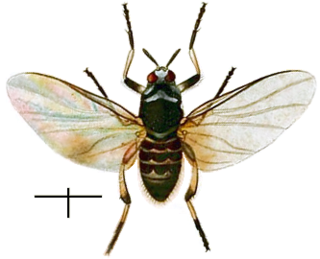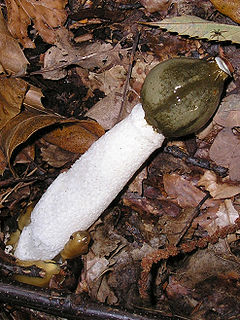| Smittium | |
|---|---|
| Scientific classification | |
| Kingdom: | Fungi |
| Division: | Zygomycota |
| Subdivision: | Kickxellomycotina |
| Order: | Harpellales |
| Family: | Legeriomycetaceae |
| Genus: | Smittium R.A.Poiss. |
| Species | |
many, see text | |
Smittium is a genus of fungi in the order Harpellales. It is the largest genus in the order. As of 2013, there were 81 described species. [1] Many of these have been formally described only recently; in 1998 there were just 46. [2] Several have been transferred to Smittium from other genera, such as Orphella , Rubetella , Genistella , and Typhella . [3] In general, the genus has a cosmopolitan distribution, but some species are limited to small regions. [1]
A genus is a taxonomic rank used in the biological classification of living and fossil organisms, as well as viruses, in biology. In the hierarchy of biological classification, genus comes above species and below family. In binomial nomenclature, the genus name forms the first part of the binomial species name for each species within the genus.

A fungus is any member of the group of eukaryotic organisms that includes microorganisms such as yeasts and molds, as well as the more familiar mushrooms. These organisms are classified as a kingdom, fungi, which is separate from the other eukaryotic life kingdoms of plants and animals.
In biological classification, the order is
- a taxonomic rank used in the classification of organisms and recognized by the nomenclature codes. Other well-known ranks are life, domain, kingdom, phylum, class, family, genus, and species, with order fitting in between class and family. An immediately higher rank, superorder, may be added directly above order, while suborder would be a lower rank.
- a taxonomic unit, a taxon, in that rank. In that case the plural is orders.
Like most other fungi of the Harpellales, these are found in the guts of insect larvae. Smittium are most often resident in the larvae of aquatic flies. The genus was named for Smittia , the midge from which it was first isolated. The fungi can be found in black flies, mosquitoes, solitary midges, and non-biting and biting midges. The relationship between the fungus and the fly is usually commensal. [1] Sometimes it is more mutualistic, such as when the fungus synthesizes vitamins or other nutrients for the host. [4] One species, though, Smittium morbosum , can best be described as parasitic on its mosquito larva host, killing it by preventing it from molting. No other gut fungi are known to be lethal to their hosts in this way. [1]
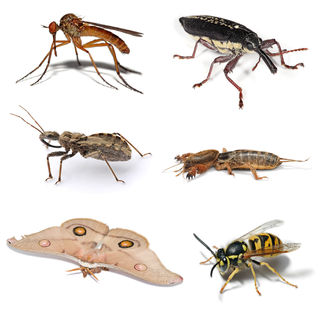
Insects or Insecta are hexapod invertebrates and the largest group within the arthropod phylum. Definitions and circumscriptions vary; usually, insects comprise a class within the Arthropoda. As used here, the term Insecta is synonymous with Ectognatha. Insects have a chitinous exoskeleton, a three-part body, three pairs of jointed legs, compound eyes and one pair of antennae. Insects are the most diverse group of animals; they include more than a million described species and represent more than half of all known living organisms. The total number of extant species is estimated at between six and ten million; potentially over 90% of the animal life forms on Earth are insects. Insects may be found in nearly all environments, although only a small number of species reside in the oceans, which are dominated by another arthropod group, crustaceans.
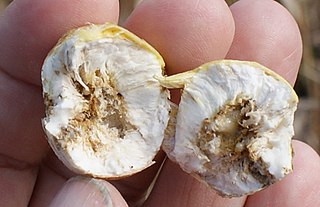
A larva is a distinct juvenile form many animals undergo before metamorphosis into adults. Animals with indirect development such as insects, amphibians, or cnidarians typically have a larval phase of their life cycle.

Flies are insects with a pair of functional wings for flight and a pair of vestigial hindwings called halteres for balance. They are classified as an order called Diptera, that name being derived from the Greek δι- di- "two", and πτερόν pteron "wings". The order Diptera is divided into two suborders, with about 110 families divided between them; the families contain an estimated 1,000,000 species, including the familiar housefly, horse-fly, crane fly, and hoverfly; although only about 125,000 species have a species description published. The earliest fly fossils found so far are from the Triassic, about 240 million years ago; phylogenetic analysis suggests that flies originated in the Permian, about 260 million years ago.
The host larva is infected with Smittium when it ingests the fungal spore. [5] Smittium generally live in the hindgut of the fly larva, attaching to the chitinous gut lining [1] via a hypha. When the fungus produces spores, they are excreted by the host. [5]

In biology, a spore is a unit of sexual or asexual reproduction that may be adapted for dispersal and for survival, often for extended periods of time, in unfavourable conditions. Spores form part of the life cycles of many plants, algae, fungi and protozoa. Bacterial spores are not part of a sexual cycle but are resistant structures used for survival under unfavourable conditions. Myxozoan spores release amoebulae into their hosts for parasitic infection, but also reproduce within the hosts through the pairing of two nuclei within the plasmodium, which develops from the amoebula.

The hindgut is the posterior (caudal) part of the alimentary canal. In mammals, it includes the distal third of the transverse colon and the splenic flexure, the descending colon, sigmoid colon and rectum. In zoology, the term hindgut refers also to the cecum and ascending colon.

Chitin (C8H13O5N)n ( KY-tin), a long-chain polymer of N-acetylglucosamine, is a derivative of glucose. It is a primary component of cell walls in fungi, the exoskeletons of arthropods, such as crustaceans (e.g., crabs, lobsters and shrimps) and insects, the radulae of molluscs, cephalopod beaks, and the scales of fish and lissamphibians. The structure of chitin is comparable to another polysaccharide - cellulose, forming crystalline nanofibrils or whiskers. In terms of function, it may be compared to the protein keratin. Chitin has proved useful for several medicinal, industrial and biotechnological purposes.
Sometimes several species can be found in the gut flora of one host. S. brevisporum , S. bulbosporophorus , and S. inexpectans have been noted growing together, for example. [3] Other genera of gut fungi can be present, as well, such as Genistellospora . [6] Some Smittium can be found in a number of hosts, while others are more host-specific. S. heterosporum has been collected from nonbiting midges of the genera Sympotthastia and Potthastia , and from Cricotopus bicinctus . S. culicis has been found in Culex pipiens and the genera Eukiefferiella and Chironomus . [3] S. chinliense was found in a crane fly larva ( Antocha sp.). [7] Host-specific Smittium include S. dimorphum , which has only been observed in the midge Boreoheptagyia lurida . [6]
Sympotthastia is a genus of non-biting midges in the subfamily Diamesinae of the bloodworm family Chironomidae.

Potthastia is a genus of non-biting midges in the subfamily Diamesinae of the bloodworm family Chironomidae.

Cricotopus bicinctus is a species of fly in the family Chironomidae. It is found in the Palearctic.
Some Smittium are useful in laboratory experiments. They are unusually easy to propagate in pure culture, and some 40% of the many Smittium species have been established as axenic isolates. [1]
In biology, axenic describes the state of a culture in which only a single species, variety, or strain of organism is present and entirely free of all other contaminating organisms. The earliest axenic cultures were of bacteria or unicellular eukaryotes, but axenic cultures of many multicellular organisms are also possible. Axenic culture is an important tool for the study of symbiotic and parasitic organisms in a controlled environment.
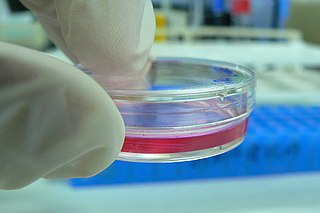
Cell culture is the process by which cells are grown under controlled conditions, generally outside their natural environment. After the cells of interest have been isolated from living tissue, they can subsequently be maintained under carefully controlled conditions. These conditions vary for each cell type, but generally consist of a suitable vessel with a substrate or medium that supplies the essential nutrients (amino acids, carbohydrates, vitamins, minerals), growth factors, hormones, and gases (CO2, O2), and regulates the physio-chemical environment (pH buffer, osmotic pressure, temperature). Most cells require a surface or an artificial substrate (adherent or monolayer culture) whereas others can be grown free floating in culture medium (suspension culture). The lifespan of most cells is genetically determined, but some cell culturing cells have been “transformed” into immortal cells which will reproduce indefinitely if the optimal conditions are provided.
Perhaps the best known species of the genus has been Smittium culisetae. It is widespread and found in several host species, especially mosquitoes. It has been used often in laboratory research. Recent morphological and molecular studies indicated that it is different from Smittium species in the positioning of its zygospore, the shape of its trichospore (a type of sporangium), the immune responses it induces in hosts, its isozymes, and other molecular characteristics. The fungus was renamed Zancudomyces culisetae and placed in a monotypic genus of its own, Zancudomyces . [1]

Morphology is a branch of biology dealing with the study of the form and structure of organisms and their specific structural features.
A zygospore is a diploid reproductive stage in the life cycle of many fungi and protists. Zygospores are created by the nuclear fusion of haploid cells. In fungi, zygospores are formed in zygosporangia after the fusion of specialized budding structures, from mycelia of the same or different mating types, and may be chlamydospores. In many eukaryotic algae, including many species of the Chlorophyta, zygospores are formed by the fusion of unicellular gametes of different mating types.

A sporangium is an enclosure in which spores are formed. It can be composed of a single cell or can be multicellular. All plants, fungi, and many other lineages form sporangia at some point in their life cycle. Sporangia can produce spores by mitosis, but in nearly all land plants and many fungi, sporangia are the site of meiosis and produce genetically distinct haploid spores.
Species include: [8]

